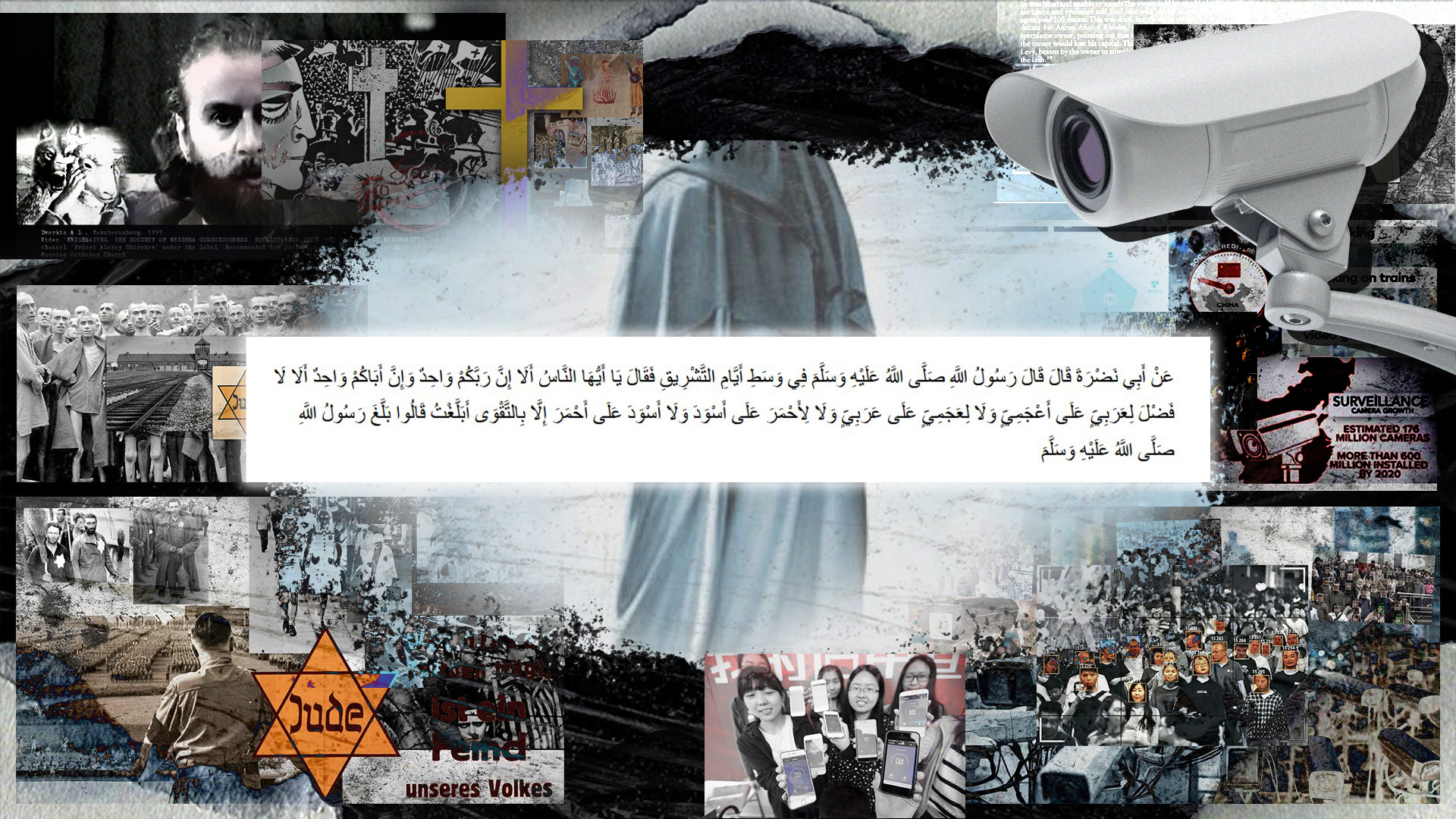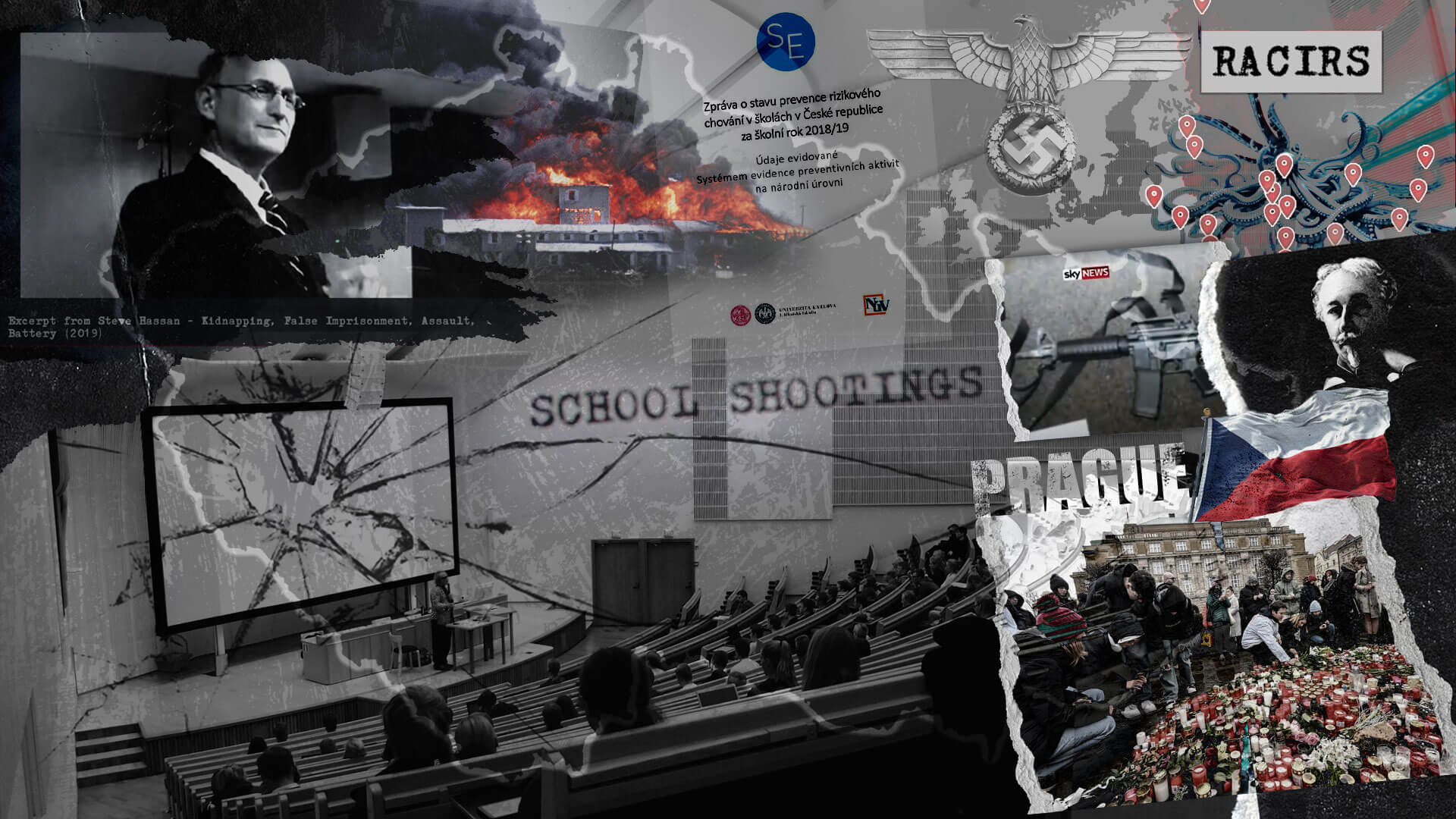Few people are aware that the forced wearing of distinctive yellow badges as a sign of artificial division and oppression was known long before the Jewish Holocaust of World War II. The Nazi regime under Hitler didn’t invent this method of stigmatization — they were prompted by others. And who else could suggest this but those who zealously carried the dark history of the past in their memory? Anti-cultists! Always operating from the shadows, hiding under the guise of various religious organizations, and inherently carrying out a perpetual terror.
This publication, based on gathered facts, will help reinforce the belief that the anti-cult ideas of inquisitors not only influenced Adolf Hitler’s views during the rise of the fascist regime, but, moreover, these inhumane ideas contributed to the beginning of the genocide against the Jews.
And not only them…
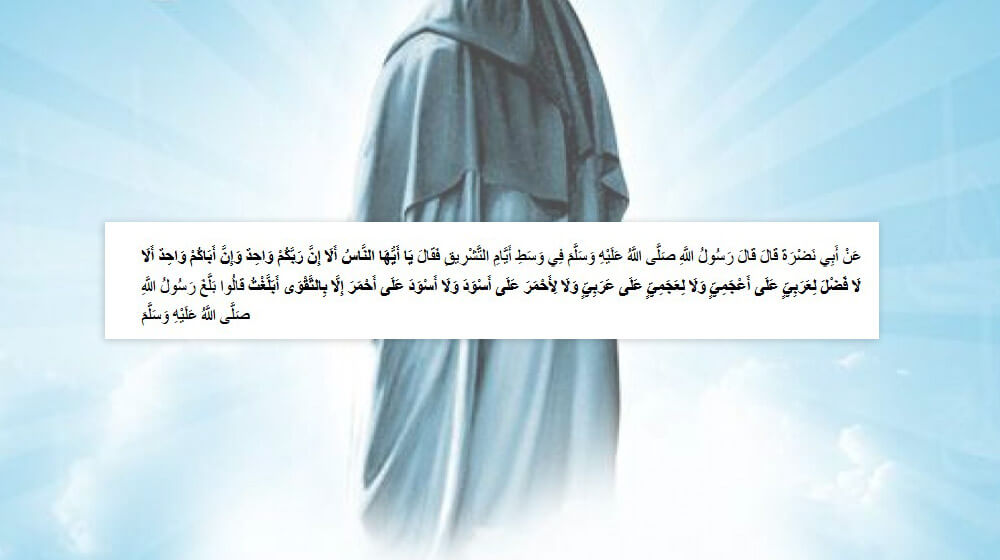
Abu Nadrah reported: “The Messenger of Allah, peace and blessings be upon him, said during the days after the pilgrimage, ‘O people, your Lord is one and your father Adam is one. There is no favor of an Arab over a foreigner, nor a foreigner over an Arab, and neither white skin over black skin, nor black skin over white skin, except by righteousness. Have I not delivered the message?‘”
Source: Musnad Aḥmad 23489 1
The First Accounts of the Yellow Badges of Shame
Although the words of Prophet Muhammad, spoken in the 7th century CE, called for the greatest unity among people, Muslim rulers who disregarded his teachings were, according to official sources, among the first to introduce badges for identifying Jews and Christians within the Muslim population by the 8th century CE. Jews and Christians, living under Sharia law, were considered “People of the Book,” whose belief in God predated the founding of Islam. As such, they were granted the right to practice their faith privately and receive state protection. In return, they paid a special tax called jizya (“tribute”) and were often required to wear identifying markers indicating their status.
The design and style of the badges for Jews varied. Under Caliph Harun al-Rashid (807 CE), Jews in Baghdad were required to wear yellow belts or fringes. During the reign of Caliph al-Mutawakkil (847-861), Jews wore a patch in the shape of a donkey, while Christians wore a figure shaped like a swine. In 1005, Jews in Egypt were ordered to wear bells on their clothing.
It is important to note that under the caliphate, these marks of identification were not necessarily intended to be punitive. They were meant to reinforce the dhimma (protected status) of Jews and Christians, granting them certain rights and protection, while simultaneously branding them as socially inferior to Muslims.
One of the earliest mentions of the forced wearing of yellow badges is found in Paul Johnson’s book, “A History of the Jews” 2, which describes events of the 12th century. A document from the Cairo Geniza, dated 1121, details the decrees from Baghdad, requiring Jews to wear specific garments:
“Two yellow badges, one on the headgear and one on the neck. Furthermore, each Jew must hang round his neck a piece of lead weighing (3 grammes) with the word dhimmi on it. He also has to wear a belt round his waist. The women have to wear one red and one black shoe and have a small bell on their necks or shoes…”

In Generali Concilio
The long-standing and sharp stance of the Roman Catholic Church on the Jewish question is well known in world history. One of the earliest documented instances came in the form of the papal bull In generali concilio (In General Council), issued in 1218 by Pope Honorius III, calling for special measures against Jews. During the Fourth Lateran Council, it was decreed that Jews and Muslims must always wear identifying marks or clothing to distinguish them from Christians. This required wearing a yellow badge and a pointed hat.

This was the final step in a series of Church measures aimed at preventing social contact between Jews and Christians. Issued as Canon 68, the decree laid the groundwork for the subsequent introduction of the so-called Jewish badge in Christian kingdoms.
In Spain and Italian territories, the wearing of distinctive badges, usually in the form of a yellow circle, was enforced only intermittently. In German-speaking Europe, a judenhut (or “Jewish hat”), a cone-shaped pointed headgear often depicted in medieval literature, was required.
The Yellow Mark of the Jews
In 1274, a statute concerning Jews in England, enacted by King Edward I, established the following rule: “Each Jew, after he is seven years old, shall wear a distinguishing mark on his outer garment, that is to say, in the form of two Tables joined, of yellow felt of the length of six inches and of the breadth of three inches.” 4
From 1315 to 1326, Emir Ismael Abu-I-Walid required Jews in Granada to wear a yellow badge. 5
In 1321, Henry II of Castile mandated that Jews wear a yellow badge. 9
In 1415, the bull of Antipope Benedict XIII required Jews to wear a yellow and red Badge: the men on their breast, the women on their forehead. 5
In 1434, Emperor Sigismund reintroduced the badge in Augsburg.
In 1528, the Council of Ten in Venice allowed the newly arrived renowned physician and professor Jacob Mantino ben Samuel to wear the usual black doctor’s cap instead of the Jewish yellow hat for several months (later made permanent) upon the recommendation of the French and English ambassadors, the papal legate, and other dignitaries whom he numbered among his patients. 6
In 1555, Pope Paul IV decreed in his book “Cum Nimis Absurdum” [“Since it is completely senseless”] that Jews must wear yellow hats.
In 1566, King Sigismund II passed a law requiring Lithuanian Jews to wear yellow hats and head coverings. The law was abolished twenty years later. 9
In 16th-century Germany, as evidenced by surviving book illustrations, Jews were mandated to wear yellow circles on their clothing.

A 16th century depiction of a Jewish couple from Worms, Germany, wearing the obligatory yellow badge; the man holds a moneybag and bulbs of garlic (often used in artistic portrayals of Jews in medieval Europe). 9
1710: Frederick William I abolished the mandatory Jewish yellow patch in Prussia in return for a payment of 8,000 thaler (about $75,000 worth of silver at 2007 prices) each. 9
In Paul Johnson’s book “A History of the Jews,” the author references similar anti-Semitic practices in the 17th century at a prison on the island of Malta.
“In 1663, the old Cromwellian Philip Skippon described the Maltese slave-prison and noted: ‘Jews, Moors and Turks are made slaves here and are publicly sold in the market. … The Jews are distinguished from the rest by a little piece of yellow cloth on their hats or caps…‘” 2

Yellow Crosses for the Cathars
However, yellow marks of contempt were not limited to Jews and Muslims; Christians were also targeted. In Western Europe during the 12th and 13th centuries, the Roman Catholic Inquisition organized the first “crusade” against the Albigensians, better known as the Cathars — a Christian religious movement that had reached its peak by that time. The Holy Tribunal, or “World’s Hand,” as the Inquisition is sometimes called, sought out and judged heretics — those who denied the tenets of Catholicism. The Church declared the Cathars heretics and imposed a special mark on these “dissidents” — a yellow cross. We will not delve into the documentary evidence and the horrors of the genocide these people endured but will refer to some sources.
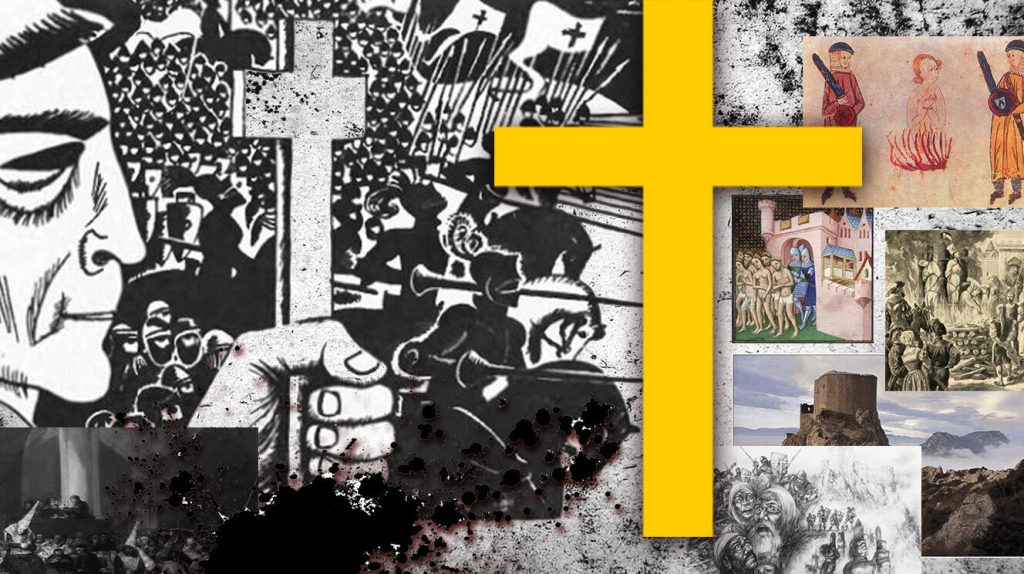
The book “The Inquisition from Its Establishment to the Great Schism” by A.L. Maycock 7.
Quotes:
“It has been pointed out that, in theory, there was no difference between the penalties inflicted by the Inquisition and the penances imposed by an ordinary confessor. Even imprisonment had long played a part in the penitential discipline of the Church; and throughout the Middle Ages, the bishops could imprison people in exactly the same manner and with exactly the same purpose as could the Inquisitors. In practice, the only penance imposed exclusively by the Inquisition was the wearing of crosses.”

“St. Dominic had prescribed that Pons Roger should have two ‘little crosses’ — cruces parvulæ — sewn upon his tunic. In 1229, the Council of Toulouse formally recognized the practice of marking converted heretics in this manner, decreeing that the crosses should not be the same color as the clothing and that they should be worn, as St. Dominic had said, upon either side of the breast. It stands to reason, therefore, that they cannot have been very large. But in 1243, the Council of Narbonne made several alterations and standardizations as to size. Clearly, by this time, the crosses were regarded as a brand of infamy and nothing more. The assembly ruled that in future, the crosses should be worn on the back and front, the one centrally upon the breast and the other between the shoulder-blades. The crosses were to be stitched upon the outer garment and were to be yellow in color. The vertical arm was to be two and a half palms in length, the transverse arm two palms; and both were to be three fingers in breadth. Further, a ‘perfected’ heretic, who for any reason was not sentenced to imprisonment, was to wear three crosses — the third being placed upon the cap in the case of a man, and upon the veil if the culprit was a woman. This was decreed in 1246 by the Council of Beziers, which prescribed also that those heretics who had deliberately lied to or concealed the truth from the Inquisitors should wear special crosses with two transverse bars.”
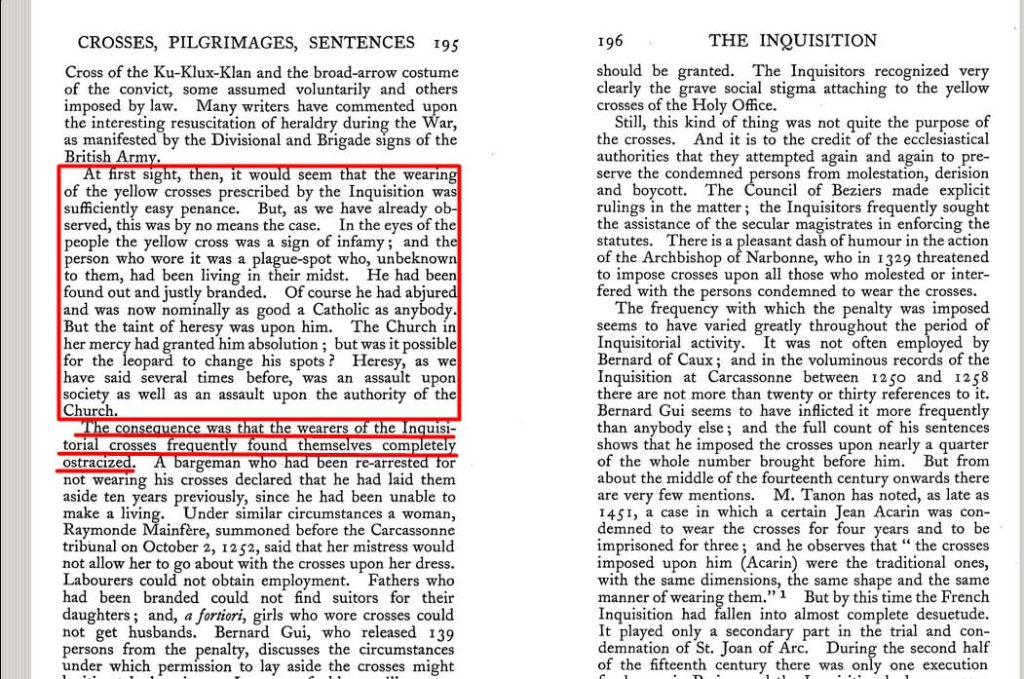
“At first sight, then, it would seem that the wearing of the yellow crosses prescribed by the Inquisition was sufficiently easy penance. But, as we have already observed, this was by no means the case. In the eyes of the people the yellow cross was a sign of infamy; and the person who wore it was seen as a plague-spot who, unbeknownst to them, had been living in their midst. He had been found out and justly branded. Of course he had abjured and was now nominally as good a Catholic as anybody. But the taint of heresy was upon him. The Church, in her mercy, had granted him absolution; but was it possible for the leopard to change his spots? Heresy, as we have said several times before, was an assault upon society as well as an assault upon the authority of the Church.
The consequence was that the wearers of the Inquisitorial crosses frequently found themselves completely ostracized.”
“The Inquisition from Its Establishment to the Great Schism” by A.L. Maycock 7
/Ostracism – from the Greek term meaning “exile” or “banishment.”/

“It is therefore of the highest significance that, in the Inquisitorial records of the Toulousain tribunals, we possess the full count of Bernard Gui’s 930 sentences from 1307 to 1323.
…
Subtracting the 271 grants of pardon and commutation of sentence, we have 659 condemnations. Of this number 307 were sentenced to terms of imprisonment and 143 to the wearing of the crosses.”
“The Inquisition from Its Establishment to the Great Schism” by A.L. Maycock 7
“The Yellow Cross” by Rene Weis 8, quote:

“The sentence stated that the penitents shall carry, from now on and forever, two yellow crosses on all their clothes except their shirts, and one arm shall be two palms long [8 inches], while the other transversal arm shall be a palm and a half long [6 inches], and each shall be three digits wide [2.25 inches], with one to be worn in front on the chest, and the other between the shoulders.”
Another quote indicates that, in some cases, individuals could pay a fee to avoid the stigma associated with the marking:

“Thus Guillaume Mondon of Ax paid Pierre Clergue the huge ransom of five pounds, the equivalent of ten sheep, to be allowed to shed the yellow crosses. This would not only remove those visible emblems of shame, but in more practical terms it would render Mondon employable again, and others would be less likely to avoid him for fear of being drawn into the maelstrom of the Inquisition.” 8
The yellow crosses of the Holy Office were a serious public mark used to identify Jews, Muslims, Christian heretics, and there is ample evidence to support this. More details about medieval historical events are covered in the article previously published on our website, “Stigmatization: Method That Leads to Genocide.”
Holocaust
The inhumane practice of stigmatizing and labeling individuals reached its horrific peak in the 20th century under the fascist regime in Germany and in occupied countries during World War II. Society witnessed true genocide, with mass shootings, death marches, and gas chambers. However, the genocide did not start spontaneously; it began with a preparatory stage of stigmatization.

The Nazis first introduced the mandatory wearing of the yellow star for Jews in occupied Poland in 1939. Authorities declared that Jews who failed to wear the yellow star on the front and back of their clothing would face severe punishment. On October 24, 1939, the city commandant of Włocławek, Oberführer Kramer, issued this order for all Jews regardless of age or gender, even before higher authorities had given their directives. This policy was quickly adopted by other German commanders in occupied territories and received official approval, given the prevailing anti-Semitic sentiments among the local Polish population, which enthusiastically supported the idea. From December 1, 1939, the wearing of the yellow star was implemented throughout the General Government. The star was most often made from a piece of yellow fabric, typically in the shape of a six-pointed star.
As we see, the very fact of forcibly wearing stigmatizing labels on the front and back of clothing, in yellow, was identical for both the Cathars in the 13th century and the Jews in the 20th century. Who inspired the Nazis with these ideas? It’s not hard to guess: representatives of religious organizations, among whom anti-cultists have always been present.
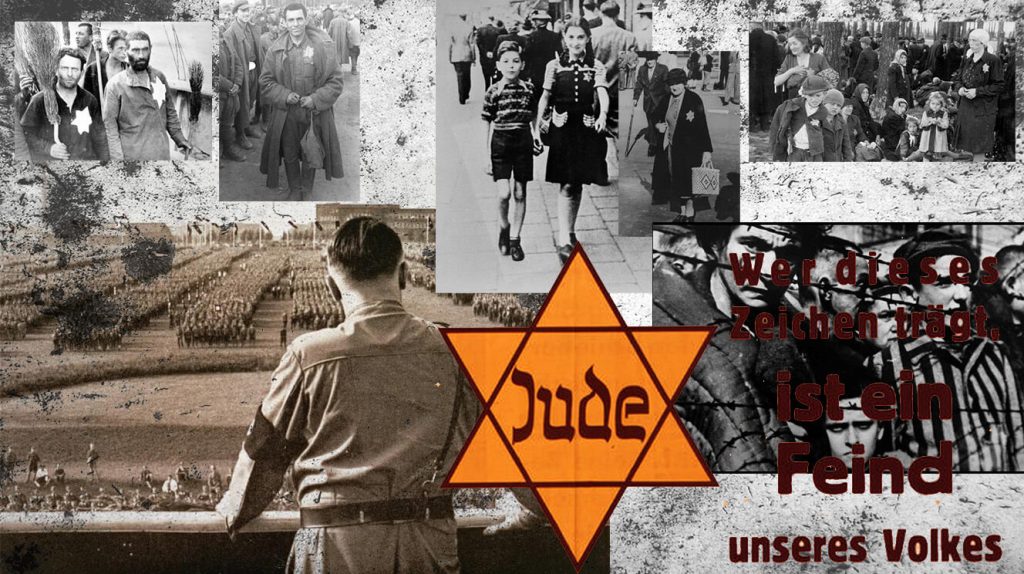
Beware of the Cultist!
It might seem that after World War II, the global community, having confronted and experienced the horrors of Nazism, recognized past mistakes, and that the revived democratic values allowed people in many countries to experience a new and better quality of life. The adoption of the Universal Declaration of Human Rights on December 10, 1948, which proclaimed and established fundamental concepts of dignity, freedom, and equality, the right to life, the prohibition of slavery and torture, and sanctioned so-called “constitutional freedoms” including spiritual, social, and political freedoms such as freedom of thought, opinion, expression, religion, and conscience, as well as freedom of association and the right to receive and disseminate information, fundamentally transformed lives around the world. Undoubtedly, society reached a new level of civilizational development.
However, the seeds of this terrible plague that caused so much suffering in the past unfortunately remained and have reemerged with renewed force over time. Stigmatization has evolved. The yellow marks on clothing have given way to the multifaceted label of “cultist” (or “sectarian”). In the past, inquisitors and Nazis, today’s missionaries, anti-cultists, and sectologists, just as those aligned with religious organizations a millennium ago, have hyped the “cult threat” as one of the most dangerous phenomena in society.

This is especially evident in Russia, where anti-cult organizations have built a large, extensive network that has gained significant influence over the past thirty years. They actively interact with politicians, law enforcement, and judicial bodies, contributing to the passage of laws that restrict freedom of religion, conscience, and thought. Through mass media and numerous interviews, they subtly introduce narratives of intolerance and hatred into public discourse, exacerbating an already tense environment. It’s worth noting that even President Putin has begun using their rhetoric in his statements. The actions of Russian anti-cultists can no longer be seen as mere religious extremism; they can confidently be regarded as terrorism.

Alexander Dvorkin is a leader of the anti-cult movement in Russia and the author of the term “totalitarian sect.” “The IMPACT” film provides a detailed examination of his prominent role, destructive methodologies, and the activities of the organizations he founded — the Center for Religious Studies in the name of Hieromartyr Irenaeus of Lyons and RACIRS. Following the film’s release, we now view these organizations as terrorist entities. In our future publications, we will revisit RACIRS, as it warrants special attention and a more thorough analysis.

In modern Russia, the term “sectarian” (“cultist”) has become as stigmatizing and damaging as “Jew” in Nazi Germany or “heretic” and Cathar in the Middle Ages. Everything is so identical that this analogy is frightening. Observing the plight of many persecuted small religious groups in Russia — accused of extremism, banned, had their property seized, and subjected their members to psychological pressure, torture, fines, and imprisonment — makes it clear that the excesses of the Inquisition are very much alive today. Though it has evolved within the framework of modern democratic norms, its essence remains unchanged.
Looking at the tragic fate of the Ukrainian people, plunged into the abyss of war and directly affected by the activities of these same anticultists — whose traces are clearly visible — one cannot but acknowledge that global terror and genocide are returning to our land.
Thanks to information from the documentary “The IMPACT” and Egon Cholakian’s video “The Crossroads,” we can now more freely work with facts, answer many questions, and gain new insights into problems that once seemed unsolvable. We can also look into the near future, where someone’s plans for a major civilizational war between the Christian and Muslim worlds are approaching realization. This does not appear to be another conspiracy theory. Recent events, such as the attempted assassination of Donald Trump, the murders of children, unrest in the UK, and the thwarted terror attack on Taylor Swift, described recently on our website, provide a clear understanding that the world is on the brink of a global upheaval orchestrated by what can be called global anti-cultists. The connections are distinctly traced to influential political and religious circles in Russia.
Why, you may ask, create global chaos?
The answer is straightforward: for someone’s total control. Therefore, the population of Russia itself, to be completely objective, can be seen as potential victims, just like everyone else.

China’s Social Credit System
In conclusion, it is worth considering another example of societal division into “good” and “outcast” categories based on anti-cult principles. It is China’s Social Credit System, also known as the “social rating” or “social trust” system.
This system assesses individuals and organizations based on a variety of parameters evaluated through numerous criteria using mass surveillance tools and big data analytics technology. It employs over 160,000 criteria, with data collected from government sources, corporations (such as Tencent, Alibaba, and Baidu), and banks. While the criteria and parameters for individuals and organizations differ, the common principle is to reward socially beneficial actions and penalize violations of laws and moral norms.

The Chinese government first published its plan for implementing this system on July 14, 2014, under the plausible goal of building a harmonious socialist society. A special commission was established under the Politburo of the Central Committee of the Communist Party of China to oversee its implementation.
Four years later, on May 1, 2018, restrictions came into effect for citizens and businesses deemed to have low reliability.
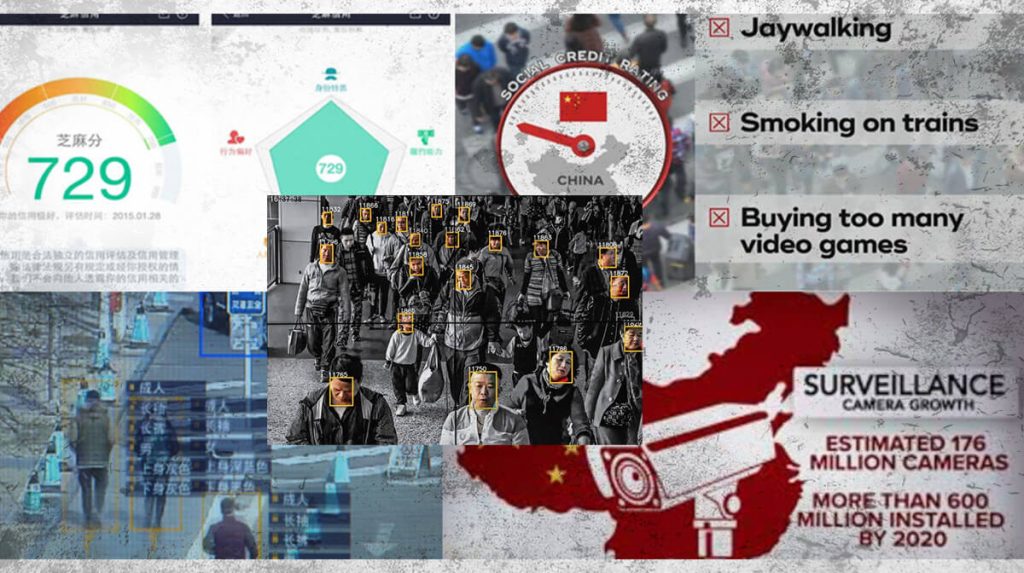
Black and Red Lists in Social Credit
Undoubtedly, everyone wants to live in a society where citizens strive for personal development and collective well-being. At first glance, the government initiative to create an ideal citizen through the social credit system seems to align with this goal. However, we must not forget the recent history of the Falun Gong movement, where around 2 million people suddenly became undesirable, and many of them were cruelly and inhumanely slaughtered. The “The IMPACT” film reveals that, under Chinese authorities’ orders, Falun Gong practitioners were even cut for human organs…
Therefore, expecting the Chinese model of an improved democratic solution is the same as indulging in hopeless illusions. Why?
Because the social credit system heavily relies on black and red lists — two poles around which this system is structured. While there are national, regional, and commercial lists with varying conditions, there exists an “joint punishments system” under which government agencies agree to punish together blacklisted people.
What do we know today? The black list includes “unreliable” citizens who have repeatedly violated laws or social norms, such as jaywalking, drunk driving, failing to pay taxes, or not repaying loans. Clearly, committing serious crimes will immediately result in being placed on the blacklist. Although activities like cheating in video games or gossiping might lower one’s rating, it is unlikely to result in being blacklisted. Sanctions include reduced internet speeds, restricted access to social and government services, and public transport (e.g., booking flights or high-speed train tickets). “Unreliable” citizens may also be denied loans, mortgages, insurance, or admission for their children to private schools. It is important to note that it is possible to be removed from the blacklist by engaging in socially valuable activities or, for example, performing heroic deeds.
Conversely, the red list includes “model” citizens who are actively involved in socially beneficial activities, such as donating to charity, giving blood, or helping the poor. For their contributions, they receive privileges like low-interest loans, deposit-free bike and car rentals, discounted mobile phone rates, and priority in school admissions or job placements.

Both lists affect social reputation. People on the “blacklist” are often publicly condemned, while exemplary citizens are held up as role models. Information about them can be seen in newspapers and on billboards.
Now for the most concerning development: in Hebei Province, a mini-program is being developed that will allow people to check if there are individuals on the blacklist nearby.
“The High People’s Court of Hebei Province, for instance, has announced a mini program (similar to an app) on WeChat called “Laolai Map,” where people can check if there are blacklisted individuals around them (Laolai means willful defaulter). Alerting against untrustworthy people nearby is done not only through online platforms but also through newspapers and street billboards. In some cities, courts collaborate with local phone companies to use a ringtone that notifies callers when a person has been blacklisted.” 10
As we can see, the prospects are far from rosy. Who will guarantee that the system won’t evolve tomorrow towards more severe suppression of civil liberties, turning into a totalitarian monster beyond dispute? And that this mournful list of Jews, Cathars, heretics, sectarians, and cultists will not expand to include China’s “unreliable” social outcasts? Just recall the 2 million Falun Gong practitioners — where would their trust rating fall? And what are they guilty of?



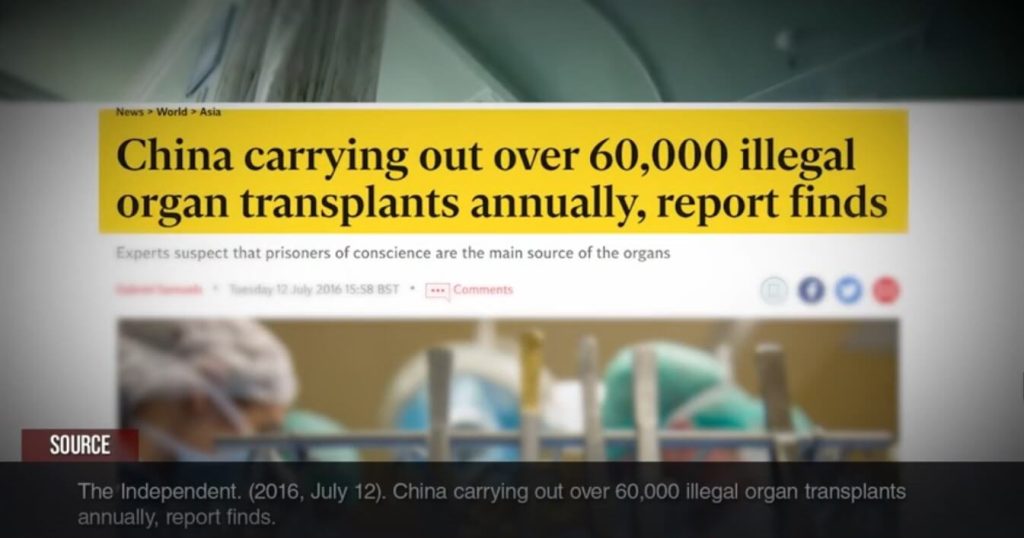

In a consumer society, such initiatives unfortunately do not grant people more freedom. On the contrary, they drive people into slavery, further consolidating power. Ordinary individuals are left with no choice but to comply out of fear of being rejected or blacklisted.
However, it is fair to note that the social credit system is currently operating on a voluntary basis and is still in a testing phase. To our knowledge, the National Development and Reform Commission and the People’s Bank of China have selected 12 cities for testing: Hangzhou, Nanjing, Xiamen, Chengdu, Suzhou, Suqian, Huizhou, Wenzhou, Weihai, Weifang, Yiwu, and Rongcheng. Additionally, it has been implemented in the Xinjiang Autonomous Region, known for its ideological re-education camps for ethnic minorities, particularly Uighurs, as well as in Shandong and Jiangsu — regions with high levels of economic development.
The genocide of Uighurs by the Chinese authorities deserves separate discussion. 11
For now, as the system is being tested, it seems to be well-received by Chinese youth.

Social Scoring in Russia
It appears that Russia is following in China’s footsteps, attempting to implement similar initiatives. Social scoring is a system for evaluating an individual’s social status and potential. To develop such a system in Russia, scientists from the Russian State Social University (RGSU) created a platform called “We” (“My” in Russian), which uses probabilistic and statistical models for evaluation. The development of this project began in 2022. The project’s authors believe it will help optimize resource allocation in the social sphere.
The official website 12 of the platform states:
“Social scoring is fundamentally an innovative tool that revolutionizes the ways in which behavioral and social characteristics and manifestations of individuals are assessed. Global experience with various functional scoring systems shows that it often serves as a tool for analysis, monitoring, and continuous improvements in areas such as healthcare, social policy, education, and the financial sector.
Such systems allow, for example, for improved performance of government services and public organizations, a relevant and objective approach to forming social support for the population, and an enhancement in the quality of life for clients and residents of the region.”
Nicely written, but what is the essence? With growing concern, we watch as nazism revives in Russia…
Conclusion
From century to century, we have witnessed inequality, oppression, and the resulting injustices that breed human suffering. The anti-cult factor of influence has played and continues to play a central role in this macabre play. Today, they are the scriptwriters, ideologists, and instigators, still hiding behind the name of God. Which God? We would like to ask.
Let us recall the words of the Prophet.
Abu Nadrah reported: “The Messenger of Allah, peace and blessings be upon him, said during the days after the pilgrimage, ‘O people, your Lord is one and your father Adam is one. There is no favor of an Arab over a foreigner, nor a foreigner over an Arab, and neither white skin over black skin, nor black skin over white skin, except by righteousness.
Have I not delivered the message?'”
Source:
1. https://www.abuaminaelias.com/dailyhadithonline/2011/12/30/lord-father-adam-one/
2. https://archive.org/details/historyofjews0000john/page/n5/mode/2up
3. https://nl.wikipedia.org/wiki/In_generali_concilio
4. https://www.bbc.co.uk/radio4/history/sceptred_isle/page/27.shtml?question=27
5. https://www.jewishencyclopedia.com/articles/2317-badge
6. https://www.jewishencyclopedia.com/articles/10379-mantino-jacob-ben-samuel
7. https://archive.org/details/MN5022ucmf_3/mode/2up
8. https://gnosis.study/library/%D0%94%D1%80%D1%83%D0%B3%D0%B8%D0%B5%20%D1%83%D1%87%D0%B5%D0%BD%D0%B8%D1%8F/%D0%9A%D0%B0%D1%82%D0%B0%D1%80%D1%8B/%D0%9A%D0%BD%D0%B8%D0%B3%D0%B8/ENG/Weis%20R.%20-%20The%20Yellow%20Cross.%20The%20Story%20of%20the%20Last%20Cathars%E2%80%99%20Rebellion%20Against%20the%20Inquisition,%201290-1329.pdf
9. https://en.wikipedia.org/wiki/Yellow_badge
10. How to Make the Perfect Citizen? Lessons from China’s Model of Social Credit System https://papers.ssrn.com/sol3/papers.cfm?abstract_id=3586503
11. https://en.wikipedia.org/wiki/Persecution_of_Uyghurs_in_China
12. https://w.rgsu.net/
